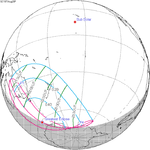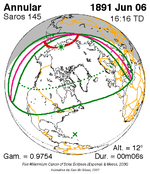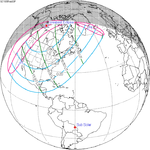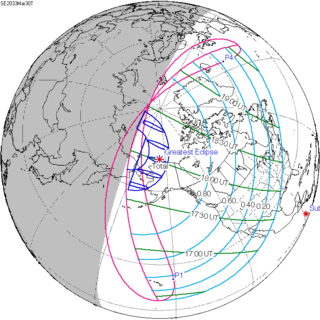
A total solar eclipse will occur at the Moon's descending node of orbit on Wednesday, March 30, 2033, with a magnitude of 1.0462. A solar eclipse occurs when the Moon passes between Earth and the Sun, thereby totally or partly obscuring the image of the Sun for a viewer on Earth. A total solar eclipse occurs when the Moon's apparent diameter is larger than the Sun's, blocking all direct sunlight, turning day into darkness. Totality occurs in a narrow path across Earth's surface, with the partial solar eclipse visible over a surrounding region thousands of kilometres wide. Occurring about 11 hours after perigee, the Moon's apparent diameter will be larger.

A total solar eclipse will occur at the Moon's ascending node of orbit on Monday, July 13, 2037, with a magnitude of 1.0413. A solar eclipse occurs when the Moon passes between Earth and the Sun, thereby totally or partly obscuring the image of the Sun for a viewer on Earth. A total solar eclipse occurs when the Moon's apparent diameter is larger than the Sun's, blocking all direct sunlight, turning day into darkness. Totality occurs in a narrow path across Earth's surface, with the partial solar eclipse visible over a surrounding region thousands of kilometres wide. Occurring about 2.6 days before perigee, the Moon's apparent diameter will be larger.

A total solar eclipse will occur at the Moon's descending node of orbit between Saturday, December 25 and Sunday, December 26, 2038, with a magnitude of 1.0268. A solar eclipse occurs when the Moon passes between Earth and the Sun, thereby totally or partly obscuring the image of the Sun for a viewer on Earth. A total solar eclipse occurs when the Moon's apparent diameter is larger than the Sun's, blocking all direct sunlight, turning day into darkness. Totality occurs in a narrow path across Earth's surface, with the partial solar eclipse visible over a surrounding region thousands of kilometres wide. Occurring about 1.7 days after perigee, the Moon's apparent diameter will be larger.
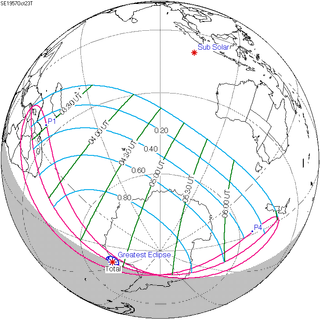
A total solar eclipse occurred at the Moon's ascending node of orbit on Wednesday, October 23, 1957, with a magnitude of 1.0013. A solar eclipse occurs when the Moon passes between Earth and the Sun, thereby totally or partly obscuring the image of the Sun for a viewer on Earth. A total solar eclipse occurs when the Moon's apparent diameter is larger than the Sun's, blocking all direct sunlight, turning day into darkness. Totality occurs in a narrow path across Earth's surface, with the partial solar eclipse visible over a surrounding region thousands of kilometres wide. Occurring about 1.4 days after perigee, the Moon's apparent diameter was larger.

A total solar eclipse occurred at the Moon's descending node of orbit between Monday, September 11, 1950 and Tuesday, September 12, 1950, with a magnitude of 1.0182. A solar eclipse occurs when the Moon passes between Earth and the Sun, thereby totally or partly obscuring the image of the Sun for a viewer on Earth. A total solar eclipse occurs when the Moon's apparent diameter is larger than the Sun's, blocking all direct sunlight, turning day into darkness. Totality occurs in a narrow path across Earth's surface, with the partial solar eclipse visible over a surrounding region thousands of kilometres wide. Occurring about 3.2 days before perigee, the Moon's apparent diameter was larger.
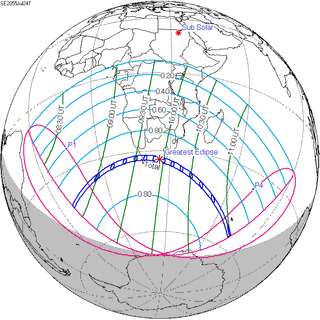
A total solar eclipse will occur at the Moon's ascending node of orbit on Saturday, July 24, 2055, with a magnitude of 1.0359. A solar eclipse occurs when the Moon passes between Earth and the Sun, thereby totally or partly obscuring the image of the Sun for a viewer on Earth. A total solar eclipse occurs when the Moon's apparent diameter is larger than the Sun's, blocking all direct sunlight, turning day into darkness. Totality occurs in a narrow path across Earth's surface, with the partial solar eclipse visible over a surrounding region thousands of kilometres wide. Occurring about 2.9 days before perigee, the Moon's apparent diameter will be larger.

A total solar eclipse will occur at the Moon's ascending node of orbit on Thursday, August 3, 2073, with a magnitude of 1.0294. A solar eclipse occurs when the Moon passes between Earth and the Sun, thereby totally or partly obscuring the image of the Sun for a viewer on Earth. A total solar eclipse occurs when the Moon's apparent diameter is larger than the Sun's, blocking all direct sunlight, turning day into darkness. Totality occurs in a narrow path across Earth's surface, with the partial solar eclipse visible over a surrounding region thousands of kilometres wide. Occurring about 3.1 days before perigee, the Moon's apparent diameter will be larger.

A total solar eclipse will occur at the Moon's ascending node of orbit between Tuesday, August 14 and Wednesday, August 15, 2091, with a magnitude of 1.0216. A solar eclipse occurs when the Moon passes between Earth and the Sun, thereby totally or partly obscuring the image of the Sun for a viewer on Earth. A total solar eclipse occurs when the Moon's apparent diameter is larger than the Sun's, blocking all direct sunlight, turning day into darkness. Totality occurs in a narrow path across Earth's surface, with the partial solar eclipse visible over a surrounding region thousands of kilometres wide. Occurring about 3.3 days before perigee, the Moon's apparent diameter will be larger.
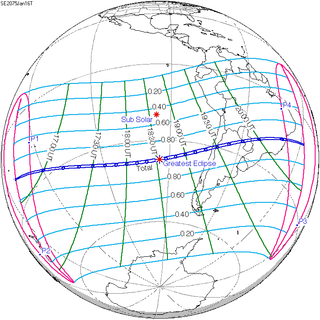
A total solar eclipse will occur at the Moon's descending node of orbit on Wednesday, January 16, 2075, with a magnitude of 1.0311. A solar eclipse occurs when the Moon passes between Earth and the Sun, thereby totally or partly obscuring the image of the Sun for a viewer on Earth. A total solar eclipse occurs when the Moon's apparent diameter is larger than the Sun's, blocking all direct sunlight, turning day into darkness. Totality occurs in a narrow path across Earth's surface, with the partial solar eclipse visible over a surrounding region thousands of kilometres wide. Occurring about 1.5 days after perigee, the Moon's apparent diameter will be larger.
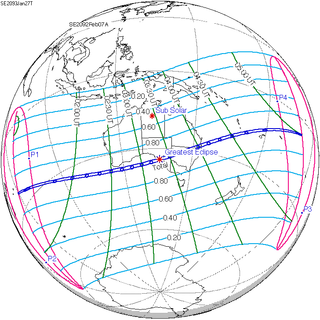
A total solar eclipse will occur at the Moon's descending node of orbit on Tuesday, January 27, 2093, with a magnitude of 1.034. A solar eclipse occurs when the Moon passes between Earth and the Sun, thereby totally or partly obscuring the image of the Sun for a viewer on Earth. A total solar eclipse occurs when the Moon's apparent diameter is larger than the Sun's, blocking all direct sunlight, turning day into darkness. Totality occurs in a narrow path across Earth's surface, with the partial solar eclipse visible over a surrounding region thousands of kilometres wide. Occurring about 1.3 days after perigee, the Moon's apparent diameter will be larger.

A total solar eclipse occurred at the Moon's descending node of orbit between Tuesday, October 21 and Wednesday, October 22, 1930, with a magnitude of 1.023. A solar eclipse occurs when the Moon passes between Earth and the Sun, thereby totally or partly obscuring the image of the Sun for a viewer on Earth. A total solar eclipse occurs when the Moon's apparent diameter is larger than the Sun's, blocking all direct sunlight, turning day into darkness. Totality occurs in a narrow path across Earth's surface, with the partial solar eclipse visible over a surrounding region thousands of kilometres wide. Occurring about 2.6 days after perigee, the Moon's apparent diameter was larger.
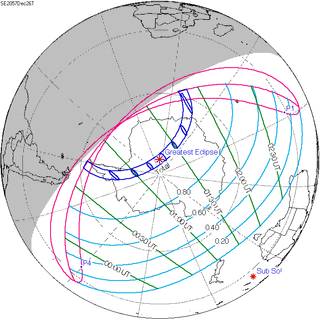
A total solar eclipse will occur at the Moon's descending node of orbit between Tuesday, December 25 and Wednesday, December 26, 2057, with a magnitude of 1.0348. A solar eclipse occurs when the Moon passes between Earth and the Sun, thereby totally or partly obscuring the image of the Sun for a viewer on Earth. A total solar eclipse occurs when the Moon's apparent diameter is larger than the Sun's, blocking all direct sunlight, turning day into darkness. Totality occurs in a narrow path across Earth's surface, with the partial solar eclipse visible over a surrounding region thousands of kilometres wide. Occurring about 6.5 hours before perigee, the Moon's apparent diameter will be larger.

A total solar eclipse will occur at the Moon's descending node of orbit between Thursday, April 10 and Friday, April 11, 2070, with a magnitude of 1.0472. A solar eclipse occurs when the Moon passes between Earth and the Sun, thereby totally or partly obscuring the image of the Sun for a viewer on Earth. A total solar eclipse occurs when the Moon's apparent diameter is larger than the Sun's, blocking all direct sunlight, turning day into darkness. Totality occurs in a narrow path across Earth's surface, with the partial solar eclipse visible over a surrounding region thousands of kilometres wide. Occurring about 1.6 days before perigee, the Moon's apparent diameter will be larger.

A total solar eclipse will occur at the Moon's ascending node of orbit on Monday, September 12, 2072, with a magnitude of 1.0558. A solar eclipse occurs when the Moon passes between Earth and the Sun, thereby totally or partly obscuring the image of the Sun for a viewer on Earth. A total solar eclipse occurs when the Moon's apparent diameter is larger than the Sun's, blocking all direct sunlight, turning day into darkness. Totality occurs in a narrow path across Earth's surface, with the partial solar eclipse visible over a surrounding region thousands of kilometres wide. Occurring about 7 hours before perigee, the Moon's apparent diameter will be larger.

A total solar eclipse will occur at the Moon's ascending node of orbit between Monday, October 3 and Tuesday, October 4, 2089, with a magnitude of 1.0333. A solar eclipse occurs when the Moon passes between Earth and the Sun, thereby totally or partly obscuring the image of the Sun for a viewer on Earth. A total solar eclipse occurs when the Moon's apparent diameter is larger than the Sun's, blocking all direct sunlight, turning day into darkness. Totality occurs in a narrow path across Earth's surface, with the partial solar eclipse visible over a surrounding region thousands of kilometres wide. Occurring about 2.3 days after perigee, the Moon's apparent diameter will be larger.

A total solar eclipse occurred at the Moon's ascending node of orbit on Saturday, May 19, 1928, with a magnitude of 1.014. A solar eclipse occurs when the Moon passes between Earth and the Sun, thereby totally or partly obscuring the image of the Sun for a viewer on Earth. A total solar eclipse occurs when the Moon's apparent diameter is larger than the Sun's, blocking all direct sunlight, turning day into darkness. Totality occurs in a narrow path across Earth's surface, with the partial solar eclipse visible over a surrounding region thousands of kilometres wide. Occurring about 7 hours after perigee, the Moon's apparent diameter was larger.

A total solar eclipse occurred at the Moon's ascending node of orbit on Thursday, October 12, 1939, with a magnitude of 1.0266. A solar eclipse occurs when the Moon passes between Earth and the Sun, thereby totally or partly obscuring the image of the Sun for a viewer on Earth. A total solar eclipse occurs when the Moon's apparent diameter is larger than the Sun's, blocking all direct sunlight, turning day into darkness. Totality occurs in a narrow path across Earth's surface, with the partial solar eclipse visible over a surrounding region thousands of kilometres wide. Occurring about 1.8 days after perigee, the Moon's apparent diameter was larger.

A total solar eclipse occurred at the Moon's descending node of orbit on Sunday, May 29, 1938, with a magnitude of 1.0552. A solar eclipse occurs when the Moon passes between Earth and the Sun, thereby totally or partly obscuring the image of the Sun for a viewer on Earth. A total solar eclipse occurs when the Moon's apparent diameter is larger than the Sun's, blocking all direct sunlight, turning day into darkness. Totality occurs in a narrow path across Earth's surface, with the partial solar eclipse visible over a surrounding region thousands of kilometres wide. Occurring about 1.2 days before perigee, the Moon's apparent diameter was larger.
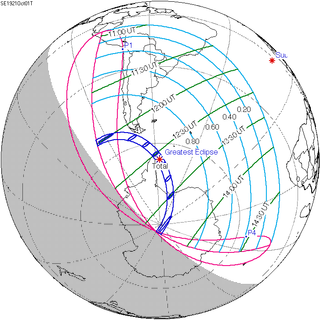
A total solar eclipse occurred at the Moon's ascending node of orbit on Saturday, October 1, 1921, with a magnitude of 1.0293. A solar eclipse occurs when the Moon passes between Earth and the Sun, thereby totally or partly obscuring the image of the Sun for a viewer on Earth. A total solar eclipse occurs when the Moon's apparent diameter is larger than the Sun's, blocking all direct sunlight, turning day into darkness. Totality occurs in a narrow path across Earth's surface, with the partial solar eclipse visible over a surrounding region thousands of kilometres wide. Occurring about 1.9 days after perigee, the Moon's apparent diameter was larger.
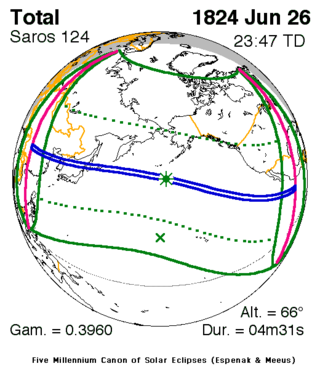
A total solar eclipse occurred at the Moon's descending node of orbit between Saturday, June 26 and Sunday, June 27, 1824, with a magnitude of 1.0578. A solar eclipse occurs when the Moon passes between Earth and the Sun, thereby totally or partly obscuring the image of the Sun for a viewer on Earth. A total solar eclipse occurs when the Moon's apparent diameter is larger than the Sun's, blocking all direct sunlight, turning day into darkness. Totality occurs in a narrow path across Earth's surface, with the partial solar eclipse visible over a surrounding region thousands of kilometres wide. Occurring about 1.9 days before perigee, the Moon's apparent diameter was larger.



















































